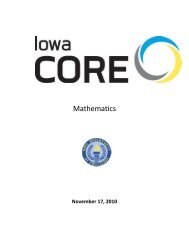The Arc's Self-Determination Scale: Procedural Guidelines
The Arc's Self-Determination Scale: Procedural Guidelines
The Arc's Self-Determination Scale: Procedural Guidelines
Create successful ePaper yourself
Turn your PDF publications into a flip-book with our unique Google optimized e-Paper software.
Chapter 2<br />
<strong>The</strong>oretical Issues<br />
<strong>Self</strong>-<strong>Determination</strong>: An Overview<br />
On June 30, 1978, Ruth Sienkiewicz-Mercer, who until that time<br />
had lived at the Belchertown State School for people with mental<br />
retardation, moved into an apartment in Springfield,<br />
Massachusetts. She described the first days of her new life in<br />
these words:<br />
“I had never had a place of my own. As a result, I had<br />
never worried about buying groceries and planning meals,<br />
paying the rent and the phone bill, balancing a checkbook,<br />
making appointments, figuring out how to keep the<br />
appointments I made -- all of the things adults just do. But<br />
starting out in society at the age of twenty-eight, after<br />
living at a state institution for the mentally retarded for<br />
sixteen years, I found these everyday tasks confusing and<br />
wonderful and frightening” (Sienkiewicz-Mercer &<br />
Kaplan, 1989, p. 202).<br />
Confusing, wonderful and frightening might be as apt a<br />
description of adulthood as any forwarded by academicians or<br />
philosophers. Reading Sienkiewicz-Mercer’s observations of her<br />
new life, perhaps the most noticeable thing is the universality of<br />
her experiences. Remove references to disability and these<br />
experiences parallel those of most young adults as they venture on<br />
their own for the first time. <strong>The</strong>re is, however, something that<br />
young people who venture into adulthood and succeed have in<br />
common. Mithaug (1991) pointed out that “in every school in this<br />
country a few children succeed regardless of the instruction they<br />
receive. Teachers identify these students early because they have<br />
purpose in their lives. <strong>The</strong>y know what they like, what they can<br />
do, what they want and how to get it” (p. ix). <strong>The</strong>se young people<br />
are, Mithaug concluded, self-determined. Appropriately, leaders<br />
in the Department of Education have identified self-determination<br />
as a critical outcome for youth with disabilities. Halloran (1993),<br />
discussing the transition services requirements of the 1990<br />
Individuals with Disabilities Education Act (IDEA), identified<br />
self-determination as the “ultimate goal of education” (p. 214).<br />
Ward (1988) called the acquisition of self-determination “a critical<br />
16
















